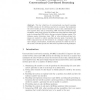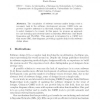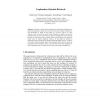EWCBR
2004
Springer
14 years 5 months ago
2004
Springer
Two key objectives of conversational case-based reasoning (CCBR) systems are (1) eliciting case facts in a manner that minimizes the user’s burden in terms of resources such as t...
EWCBR
2004
Springer
14 years 5 months ago
2004
Springer
Taxonomic case retrieval systems significantly outperform standard conversational case retrieval systems. However, their feature taxonomies, which are the principal reason for thei...
EWCBR
2004
Springer
14 years 5 months ago
2004
Springer
Abstract. In this paper, we describe a CBR system for applying musically acceptable tempo transformations to monophonic audio recordings of musical performances. Within the tempo t...
EWCBR
2004
Springer
2004
Springer
Facilitating CBR for Incompletely-Described Cases: Distance Metrics for Partial Problem Descriptions
14 years 5 months ago
A fundamental problem for case-based reasoning systems is how to select relevant prior cases. Numerous strategies have been developed for determining the similarity of prior cases,...
EWCBR
2004
Springer
14 years 5 months ago
2004
Springer
The complexity of software systems makes design reuse a necessary task in the software development process. CASE tools can provide cognitive assistance in this task, helping the so...
EWCBR
2004
Springer
14 years 5 months ago
2004
Springer
The definition of similarity measures—one core component of every CBR application—leads to a serious knowledge acquisition problem if domain and application specific requirem...
EWCBR
2004
Springer
14 years 5 months ago
2004
Springer
Over the years, many successful applications of case-based reasoning (CBR) systems have been developed in different areas. The performance of CBR systems depends on several factor...
EWCBR
2004
Springer
14 years 5 months ago
2004
Springer
This paper is based on the observation that the nearest neighbour in a case-based prediction system may not be the best case to explain a prediction. This observation is based on t...
EWCBR
2004
Springer
14 years 5 months ago
2004
Springer
When events such as severe weather or congestion interfere with the normal flow of air traffic, air traffic controllers may implement plays that reroute one or more traffic flows. ...
EWCBR
2004
Springer
14 years 5 months ago
2004
Springer
Because of the volume of spam email and its evolving nature, any deployed Machine Learning-based spam filtering system will need to have procedures for case-base maintenance. Key t...




